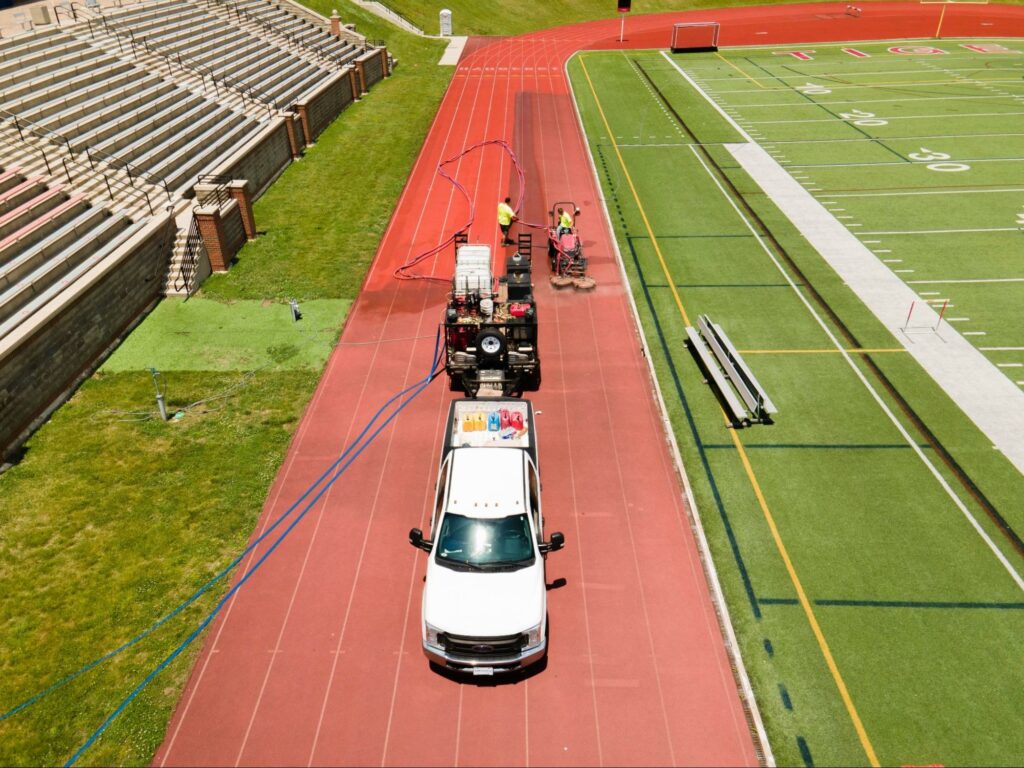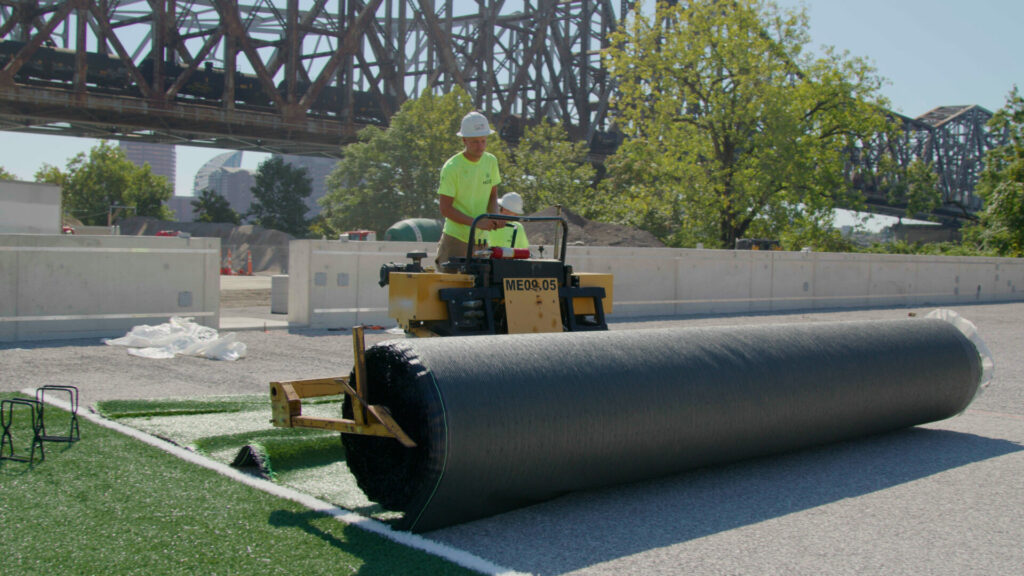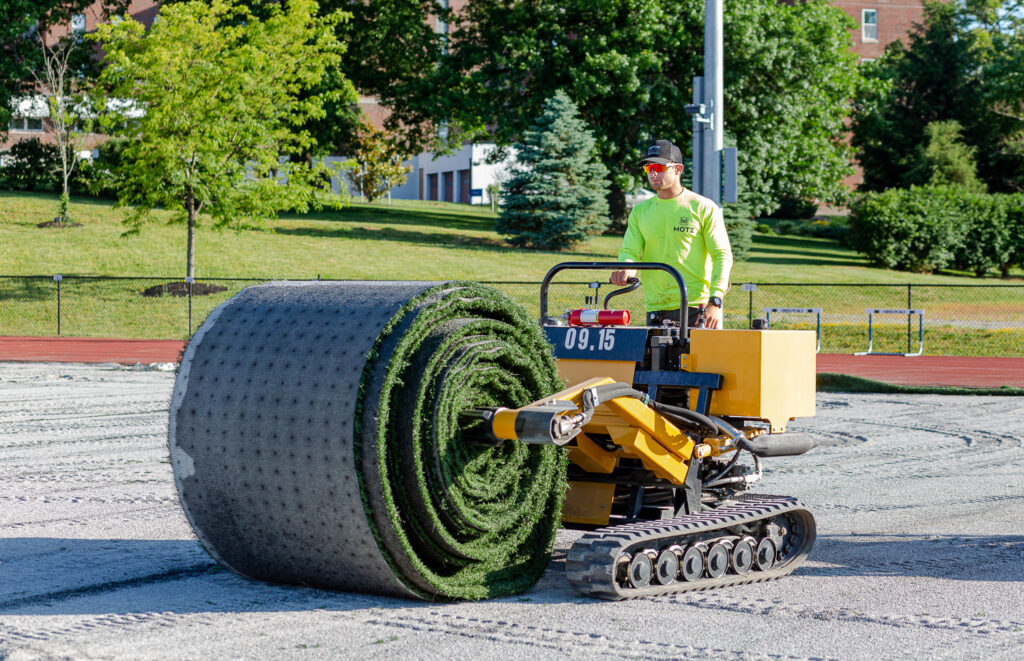
Sports Field Blog
Subscribe To Email Updates
Subscribe to our weekly newsletter and we’ll send updates straight to your inbox
Performance Testing on Artificial Turf Sports Fields
There are many testing standards within the synthetic turf industry for different sports and surface types, but none are more exacting than the FIFA Quality Programme. These standards, last updated in 2021, ensure turf surfaces meet players’ needs with various aspects of safety, performance, durability, quality assurance, and playing comfort.
High-performance sports turf fields that meet these standards can be designated with a FIFA quality mark, usually visible in the field itself or used in marketing and promotional materials.
How Do You Test Artificial Turf?
Testing artificial turf involves a comprehensive process typically including laboratory and field tests conducted by accredited testing centers or laboratories. There are over 26 tests involved in FIFA certification. Here, we cover three:
3 Types of FIFA Standard Testing on Sports Turf
Three commonly referenced tests within FIFA standards are Vertical Deformation, Energy Restitution, and Shock Absorption (formerly known as Force Reduction), completed using the Advanced Artificial Athlete (AAA – Figure 1); and Rotational Resistance, using a mechanical torque wrench (Figure 2) attached to a weighted test foot with cleat studs (Figure 3). Let’s go into these tests in a little more detail:
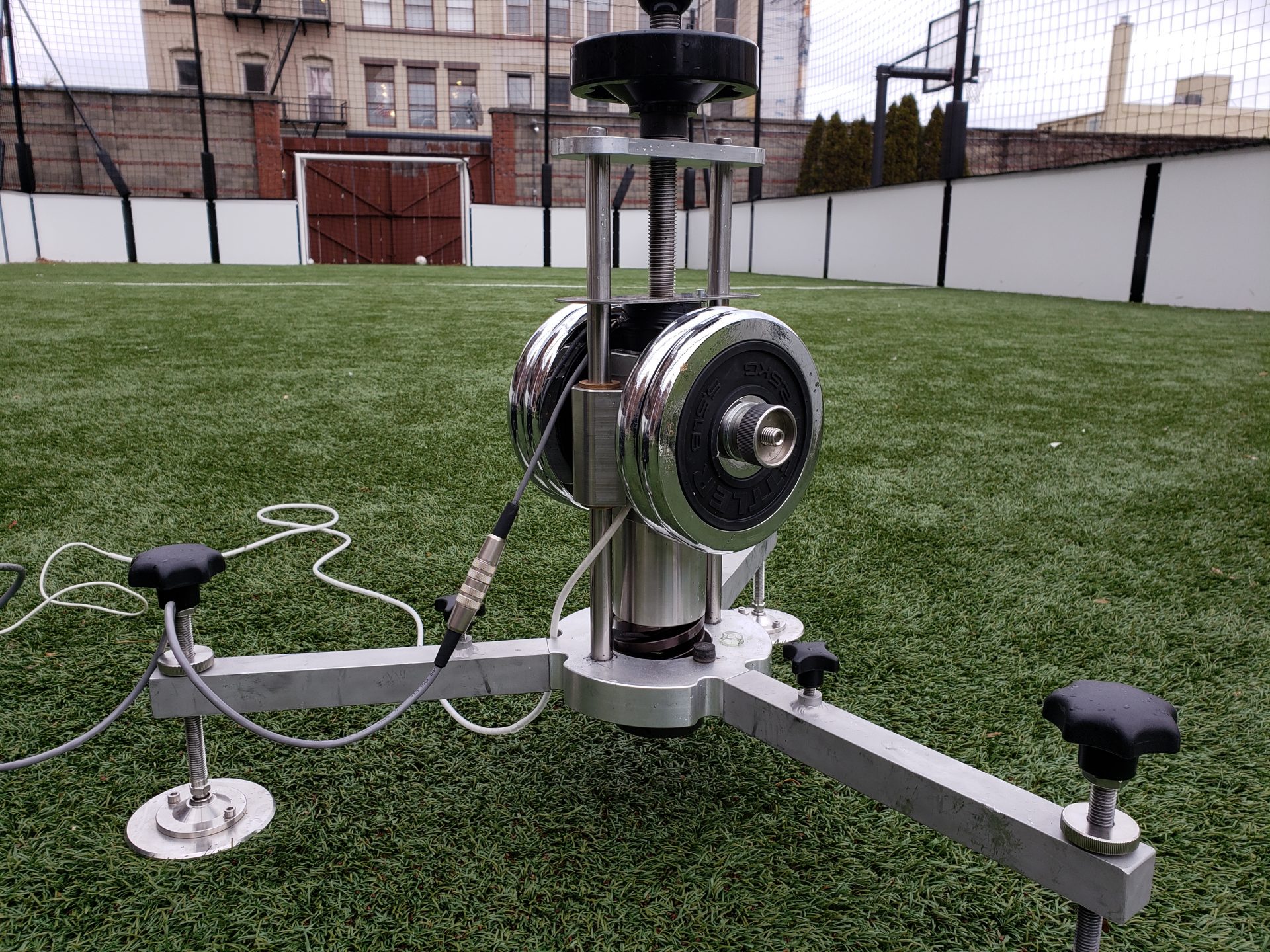 | 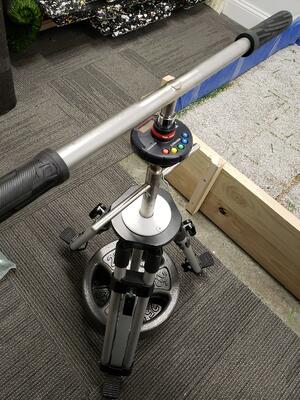 | 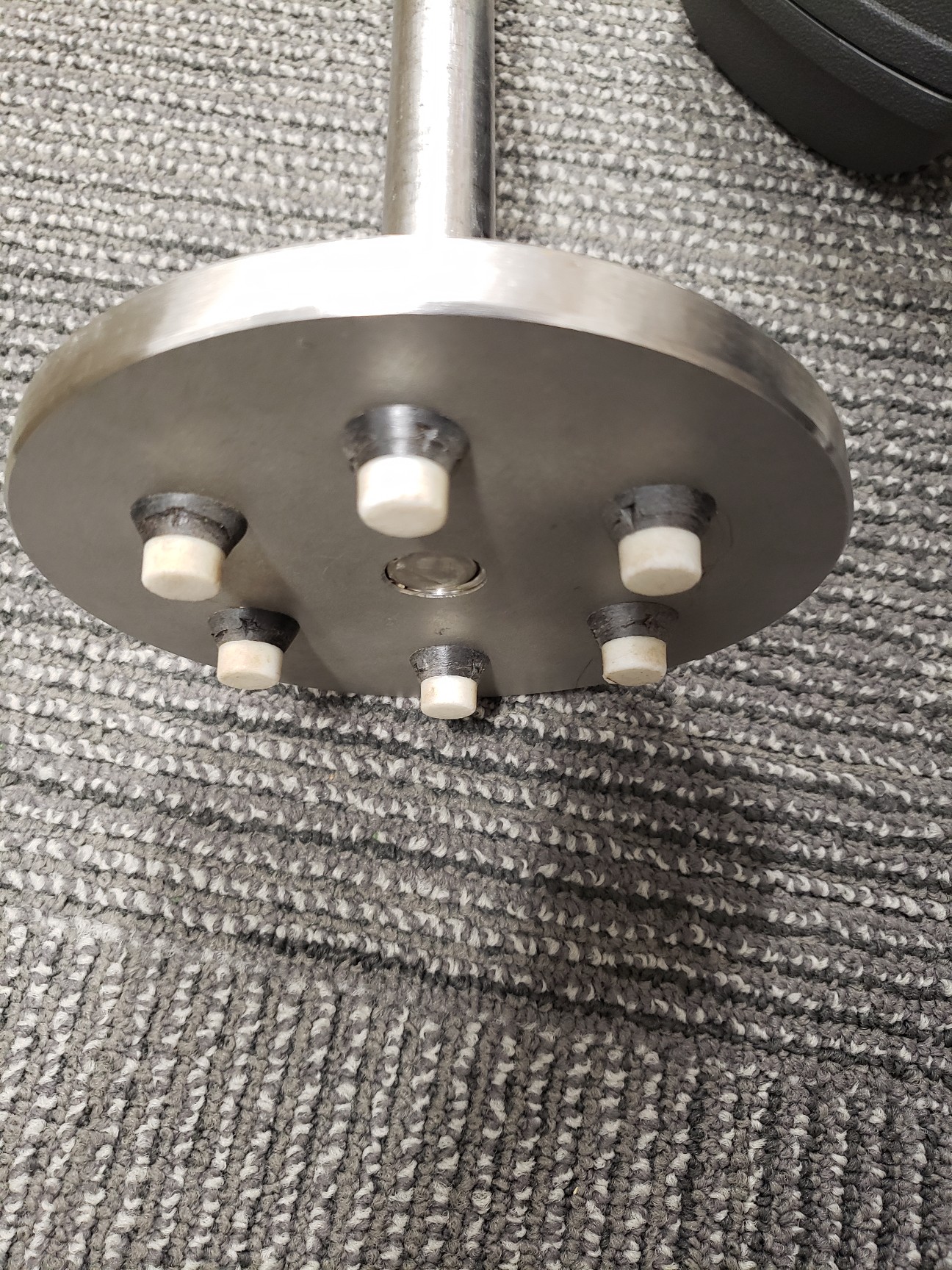 |
| Figure 1 – Advanced Artificial Athlete (AAA) | Figure 2 – Rotational Resistance | Figure 3- Cleat Studs |
1. Vertical Deformation
Vertical deformation measures how much a surface yields underfoot, essential for mimicking the firm yet forgiving nature of natural grass. To picture this, think about planting your foot onto a concrete floor versus a trampoline. The concrete floor would have a very low vertical deformation while a trampoline would be high. Athletes want a high-performance sports turf surface with some give to help protect their ankles and joints.
Why conduct a vertical deformation test?
Vertical deformation is an indicator of player safety, ensuring the turf effectively absorbs impact to protect ankles and joints without compromising performance consistency. Vertical deformation tests confirm the synthetic turf surface provides a responsive and intuitive playing experience and offers insights into the turf’s durability, predicting a longer lifespan through sustained performance characteristics.
2. Shock Absorption
We assess shock absorption on synthetic turf fields using a GMAX test, which measures impact attenuation – the ability of the playing surface to absorb the “shock”, or kinetic energy – from a collision, such as a player falling.
The lower the GMAX rating, the more energy the surface absorbs. Alternatively, the higher the GMAX rating, the less energy the surface absorbs, meaning more energy is returned to the player.
Motz performs this test as part of our Motz365 turf maintenance program, Field Aide, our deep cleaning service, and whenever it’s required as part of installing a new field.
We drop a 20-lb, flat-ended missile on “high-traffic” areas on the synthetic turf surface. There are 10 typical locations on a field that are tested and scored, including midfield, goal lines, batter’s boxes, and more. Then, we average all location scores for the entire field. GMAX scores should not exceed a score of 200 G’s according to ASTM international, or a score of 165 G’s according to the Synthetic Turf Council.
Another test uses equipment like the Advanced Artificial Athlete, which simulates the impact of a human foot by dropping a weight from a specified height onto the turf. This weight is equipped with a force sensor to measure the peak force upon impact.
Why conduct a shock absorption test
A shock-absorbent turf can dissipate the energy from impacts, crucial for minimizing the risk of injuries such as concussions. This test ensures the turf mimics natural grass’ shock-absorbing qualities for a consistent and safe playing surface that lasts.
3. Rotational Resistance
Rotational resistance evaluates the turf’s grip, balancing the need for traction without risking player injury from excessive force. Cleat studs are attached to a weighted device that measures traction in Newton meters (Nm) when turned. A higher score indicates higher traction, while a lower score indicates low traction.
Why conduct a rotational resistance test?
The turf surface needs to balance sufficient grip for activities like turning, planting, and sudden direction changes, without causing the foot to stick excessively, which could lead to lower limb injuries. A synthetic turf surface with the right amount of rotational resistance lets players move naturally and confidently, supporting precise footwork and minimizing energy loss during play. This is important, because consistent traction across the field can significantly impact the outcome of competitive play.
A note on FIFA scoring: You may instinctively want your turf to score at the minimum or maximum for some of these tests, but in fact, there is an ideal range, according to FIFA. These ranges have been set based on scores from testing conducted on natural turf fields. Below are the ideal FIFA ranges for the tests mentioned above:
| Test | Vertical Deformation | Shock Absorption | Rotational Resistance |
|---|---|---|---|
| SCORE RANGE (LAB) | 4 to 11 mm | 57 to 68% | 27 to 48 Nm |
| SCORE RANGE (FIELD) | 4 to 11 MM | 55 to 77% | 25 to 50 Nm |
Other Important Performance Tests to Consider
Although not part of the current FIFA standard, Energy Restitution, GMAX, and HIC tests are still vitally important. They focus on a holistic approach to turf performance and safety.
Discover the benefits of these additional performance tests below:
- Energy Restitution
Energy restitution reflects the dynamic interaction between the player and the surface. A good way to think about this is to imagine running on the beach, and compare that to running over compacted wet sand. The latter will have higher energy restitution, meaning more energy is being returned to the individual. Running over dry sand that gives underfoot will return less energy because the surface absorbs most of it.
Why conduct an energy restitution test?
Too much restitution might lead to a surface that feels too hard, potentially increasing fatigue and injury risk, while too little could decrease players’ energy, making the turf feel sluggish and hindering performance. By fine-tuning energy restitution, tests ensure the turf supports natural, efficient movement, mirroring the energy feedback of natural grass and enhancing the player’s ability to perform sustained, high-intensity activities.
- G-max
The “G” in G-max testing stands for “g-force” or “gravitational force equivalent.” G-max is a measure of the maximum acceleration experienced during an impact, expressed in units of G’s. This test involves dropping a 20-lb, flat-ended missile akin to a torso or body part and then measures how well the turf system absorbs the impact. G-max scores should not exceed a score of 200 G according to the American Society for Testing and Materials (ASTM).
Learn more about G-max testing from our blog.
Why conduct a G-max test?
G-max tests the turf’s ability to absorb kinetic energy. A lower G-max value signifies a softer landing, which is key to reducing the severity of injuries from falls or tackles. Consistently low G-max ratings across a field can indicate a uniformly safe playing environment, whereas variations might identify areas in need of maintenance.
- Head Injury Criterion (HIC)
To test for HIC, a 10.1 lbs hemispherical missile, designed to simulate the shape and weight of the average human head, is dropped from various heights, and the impact of the fall is measured. Within the missile is a device that measures the acceleration (severity) of the missile at impact. The HIC tests provide a value on a scale of 0 to 2,000 and correlate to a drop height at which a score of 1,000 is achieved. This height is called the critical fall height. World Rugby has adopted a 1.3-meter standard which means that at 1.3m, the HIC score must be less than 1,000.
Why conduct a HIC test?
HIC Testing measures the synthetic turf system’s capacity to prevent head injuries, a paramount concern in sports safety. By simulating head impacts, this test provides a quantifiable measure of the turf’s ability to cushion falls, directly relating to the risk of concussions and other head trauma. A lower HIC value indicates a safer playing surface, essential for player confidence and welfare.
How To Review Performance Testing Results
Tests can either be conducted on the field, under variable conditions, or in a controlled lab environment. When reviewing test results, bear in mind there will be slight differences between the two.
“Lab testing occurs over concrete, and field testing is typically over a gravel base,” Jeff Gentile, Director of Operations at Firefly Athletics/Sports Labs USA, told us. “The impact [on] the performance scores is often a slightly softer surface after installation compared with the system when tested in the lab.”
How Can You Tell if Artificial Grass is Good Quality?
While the above tests offer objective metrics for safety and performance, assessing the quality of an artificial turf field also involves examining its physical and functional characteristics. These include:
- Appearance: The turf must possess a realistic appearance. The grass blades should remain upright and responsive underfoot, just like natural grass.
- UV resistance and color fastness: A synthetic turf should maintain its color and integrity under sunlight.
- Structural integrity and drainage efficiency: A synthetic turf system should have strong backing that keeps fibers securely in place, and an effective drainage system, capable of handling water flow during any weather.
- Safety and environmental considerations: Quality turf should be free from harmful metals and other hazardous substances for the health of players and the environment. Motz’s Envirofill and Safeshell infills are great options for this.
- Warranty and manufacturer reliability: A trustworthy warranty reflects the manufacturer’s confidence in their product’s performance and durability.
Want A High-Performance Turf? Call Motz.
There are a lot of turf system characteristics to consider when designing a synthetic turf field. To learn more about what to consider for your upcoming synthetic turf field, call Motz and speak with one of our team members.
Similar Blogs
